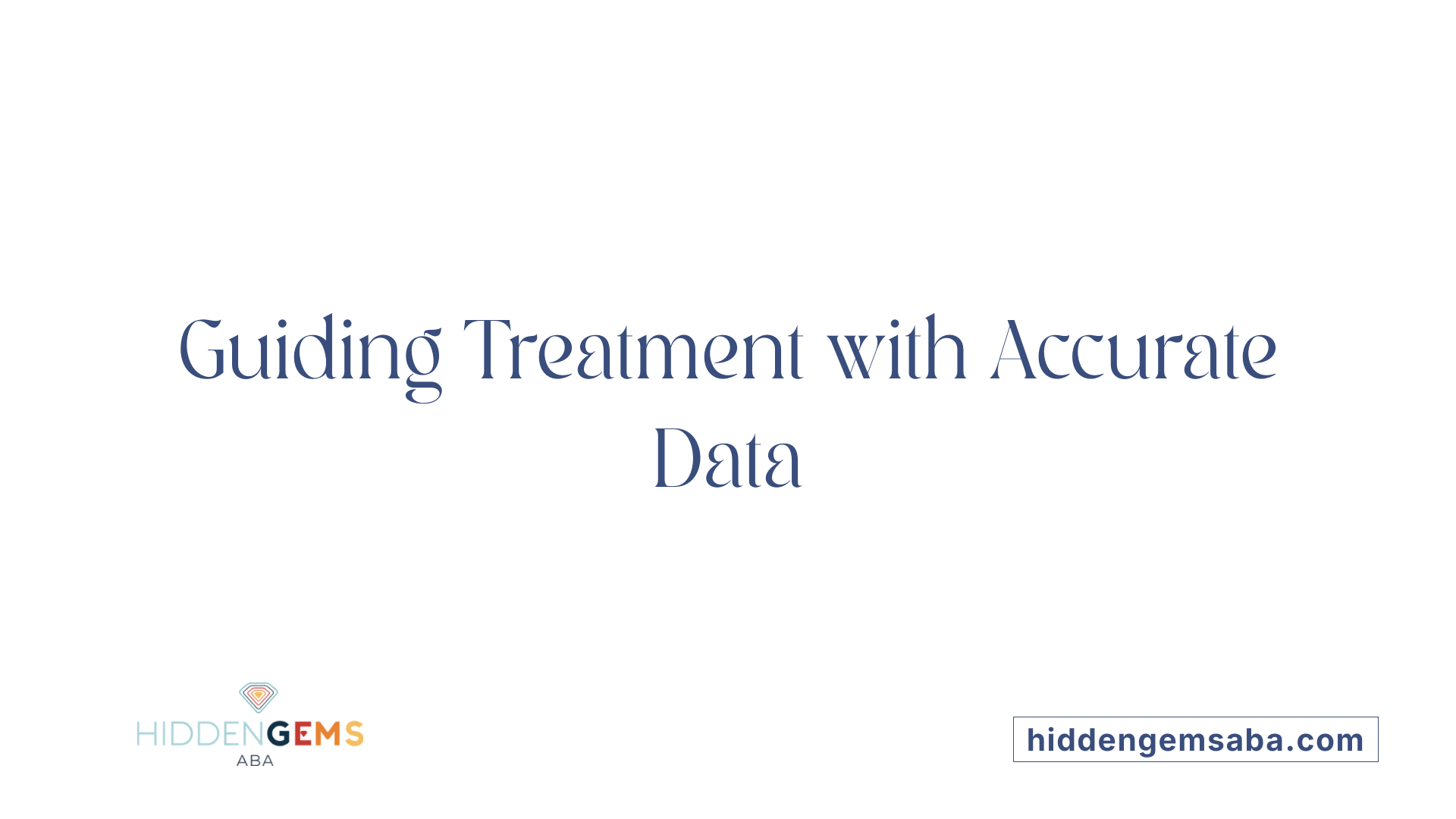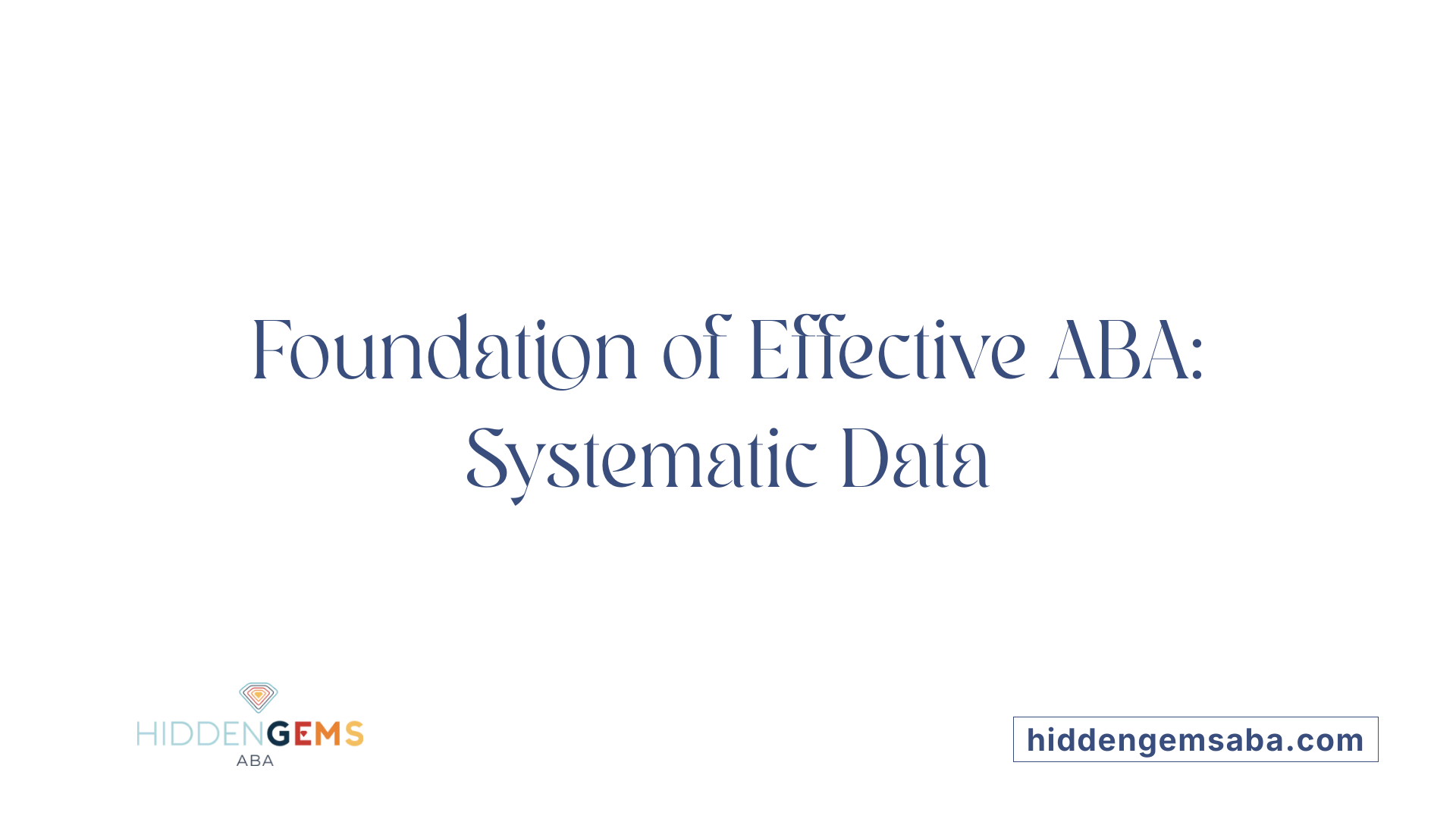Understanding the Role of Data Collection in ABA Therapy
Applied Behavior Analysis (ABA) is renowned for its systematic approach to understanding and improving behaviors through targeted interventions. Central to its success is the meticulous collection and analysis of data, which serves as the foundation for informed decision-making and tailored treatment plans. This article explores how data collection in ABA therapy drives progress, enhances the effectiveness of interventions, and provides objective measures to track behavioral changes over time.
The Primary Purpose of Data Collection in ABA Therapy

What is the primary purpose of collecting data on client behavior?
At the heart of applied behavior analysis (ABA) therapy lies data collection, a systematic process that captures behavioral and environmental variables. Its main goal is to provide an objective foundation for making informed decisions about treatment. By gathering accurate data on behaviors before, during, and after interventions, therapists can assess whether strategies are effective and identify specific patterns or triggers.
This process allows clinicians to monitor client progress over time, ensuring that interventions are personalized and responsive to the client’s evolving needs. Through continuous data collection, therapists can detect when an approach is working or if adjustments are necessary to enhance effectiveness.
Moreover, objective data promotes transparency and accountability among all stakeholders—including clients, caregivers, and other professionals. Regular review of behavioral data supports evidence-based practices, ensuring that interventions are grounded in reliable information.
In summary, the primary purpose of collecting data in ABA therapy is to guide treatment decisions, optimize outcomes, and foster a collaborative, transparent process focused on meaningful progress for each client.
Methods and Tools for Data Collection in ABA

Why is data collection important in ABA therapy?
Data collection is vital in Applied Behavior Analysis (ABA) because it provides an objective foundation for understanding, analyzing, and modifying behavior. By systematically recording behaviors and environmental variables, therapists can accurately track progress and evaluate the effectiveness of interventions.
Consistent data collection enables practitioners to identify behavioral patterns, triggers, and consequences that influence behavior. This helps in making informed decisions about which strategies are working and when adjustments are needed. Additionally, shared data fosters collaboration among therapists, clients, and caregivers, ensuring all stakeholders are aligned in treatment goals.
Using various data collection methods—such as frequency, duration, ABC data, and interval recording—therapists gather comprehensive insights tailored to each individual. Incorporating input from family members further enriches the data, making interventions more personalized and effective. Overall, data collection supports evidence-based practice, accountability, and sustained behavioral change.
What are the common methods and tools used in ABA data collection?
ABA practitioners utilize a range of methods to gather precise behavioral data. Some of the most common methods include:
| Method | Description | Purpose / Use Case |
|---|---|---|
| Frequency Recording | Tracks how often a behavior occurs | Monitoring incidents of specific behaviors, like tantrums or requests |
| Duration Recording | Measures how long a behavior lasts | Useful for behaviors like attention span or vocalizations |
| Latency Recording | Records the time between a stimulus and response | Determines how quickly a client responds to cues |
| Inter-Response Time (IRT) | Measures the time between two consecutive responses | Helps analyze spacing and patterns in behaviors |
| Interval Recording | Notes if a behavior occurs during specific intervals | Suitable for periodic behaviors over set times |
| Time Sampling | Observes behaviors at preset moments (e.g., momentary time sampling) | Provides snapshots of behaviors in natural settings |
| ABC Data (Antecedent-Behavior-Consequence) | Records what happens before and after a behavior | Identifies triggers and reinforcement patterns |
| Scatterplot Analysis | Visualizes when behaviors happen over time | Detects patterns and preferred times for behaviors |
These methods are supported by advanced software solutions like Raven Health. Such platforms enable therapists to record data in real-time, customize data sheets, and analyze behavioral patterns efficiently.
How modern tools enhance data collection and analysis
Raven Health’s all-in-one, AI-powered platform exemplifies modern ABA data collection tools. It supports various collection methods, automates data entry, and reduces manual errors. The software offers real-time data collection, customizable templates, and visualization tools such as graphs and charts, making it easier for therapists to interpret trends.
This technology not only streamlines workflows but also ensures data security and facilitates collaboration among all involved stakeholders. By enabling instant analysis and adjustments based on actual data, these tools significantly enhance the effectiveness of ABA interventions.
| Tool Feature | Benefit | Example |
|---|---|---|
| Real-time Data Entry | Immediate feedback and session adjustments | Adjust intervention immediately if a goal is not being met |
| Custom Data Sheets | Tailored to individual client needs | Tracking specific behaviors unique to each client |
| Data Visualization | Easy interpretation of patterns and trends | Graphs depicting progress over time |
| Data Security | Protects sensitive client data | Ensuring compliance with privacy standards |
In conclusion, combining traditional data collection methods with modern technological tools ensures a precise, efficient, and collaborative approach in ABA therapy, leading to better outcomes for clients.
The Significance of Systematic Data Collection

Why is collecting data on behavior important?
In Applied Behavior Analysis (ABA), gathering data is the foundation for effective therapy. It provides clear, factual insights into a person's behaviors, environmental cues, and the impact of interventions. This objectivity is vital because it moves therapy decisions from guesswork to evidence-based practices.
Systematic data collection allows therapists to see patterns and understand what triggers certain behaviors. For example, tracking the frequency, duration, or latency of a behavior helps identify when and why it occurs. These insights are essential for developing personalized treatment plans that are relevant and impactful.
By continuously analyzing collected data, practitioners can monitor a client's progress over time. Trends and behavior patterns emerge, guiding informed decision-making.
When interventions are based on accurate data, they become more targeted and effective. Adjustments can be made promptly if a strategy isn't producing expected results, ensuring the therapy remains relevant.
Moreover, data collection fosters transparency and accountability among all stakeholders, including therapists, clients, and caregivers. Shared access to progress reports promotes collaborative discussions about treatment goals and outcomes.
Effective data collection, whether through modern software like Raven Health or traditional methods such as ABC data or interval recording, ensures consistency and fidelity in therapy. It empowers practitioners to evaluate the success of interventions systematically and make necessary modifications.
Overall, systematic behavioral data collection acts as a guide in ABA, helping to craft tailored strategies, monitor progress, and achieve sustainable growth. It makes the therapy more transparent, evidence-based, and adaptable to each individual's evolving needs.
Real-Time Feedback and Its Impact on Outcomes

How does accurate data support decision-making and progress evaluation in ABA interventions?
Accurate data is essential in ABA therapy because it provides an objective foundation for assessing a client's behavioral changes and the success of specific interventions. By systematically recording behaviors, therapists can identify patterns and triggers, helping to uncover the functions behind behaviors. This detailed information allows for the development of highly targeted and personalized strategies.
Monitoring progress over time enables therapists to make timely adjustments during sessions. For example, if data shows that a particular method isn't producing expected results, the therapist can modify the approach immediately.
Data visualization tools such as charts and graphs further assist in interpreting trends, making it easier for all stakeholders—therapists, clients, and caregivers—to understand progress clearly. These visual aids help highlight improvements or plateaus, guiding adjustment decisions.
The process of collecting, analyzing, and visualizing data collectively ensures that therapy remains relevant and effective. It promotes transparency and collaboration among all involved, fostering trust and shared commitment to the client's growth.
Immediate adjustments during sessions
Real-time data collection allows therapists to respond instantly during therapy sessions. For instance, if a child's behavior worsens, immediate data alerts the therapist to alter their approach, perhaps by changing prompts or offering reinforcement.
This prompt response can prevent behaviors from escalating and reinforce positive behaviors more effectively. Therapists can document the effects of any adjustments, further informing future sessions.
Continuous progress monitoring
Ongoing measurement of behaviors helps track a client's development over days, weeks, or months. Such consistent monitoring ensures that progress is sustained and objectives are met, providing a clear picture of what strategies work best.
Therapists compare current data with baseline measurements to evaluate improvements and identify areas needing more focus. When progress stalls, data signals the need to explore alternative interventions.
Data visualization tools
Visual tools like line graphs, bar charts, and scatterplots make complex data accessible. These tools help identify behavioral trends, such as increased communication skills or decreased problematic behaviors.
For example, a scatterplot might reveal patterns in disruptive behaviors related to specific triggers or times of day. Visual insights guide decision-making by illustrating what strategies yield positive results.
Table 1: Common Data Collection Methods in ABA
| Method | Purpose | Use Cases |
|---|---|---|
| Frequency Recording | Counts how often a behavior occurs | Measuring aggression episodes |
| Duration Recording | Total time a behavior lasts | Tracking tantrum lengths |
| Latency Recording | Time from a cue to behavior | Assessing prompt effectiveness |
| ABC Data | Antecedent-Behavior-Consequence | Identifying triggers |
Modern platforms like Raven Health facilitate real-time data entry, analysis, and secure sharing. Automation reduces errors and streamlines workflows, empowering therapists to focus more on the client.
In summary, accurate, real-time data is a cornerstone of effective ABA therapy. It ensures that decisions are evidence-based, interventions are tailored, and progress is maximized, ultimately leading to better outcomes for clients.
The Role of Data in Personalizing and Optimizing Interventions

Why is collecting data on behavior important?
In Applied Behavior Analysis (ABA), gathering detailed data on behavior serves as a foundation for creating effective, personalized interventions. This systematic collection of behavioral information provides objective and evidence-based insights that are essential for understanding individual patterns, triggers, and responses.
Data collection allows therapists to track behaviors before, during, and after intervention efforts. By analyzing these patterns over time, behavior analysts can refine their strategies, ensuring they are tailored specifically to each person's unique needs. This data-driven approach reduces guesswork and reliance on subjective observations, promoting more accurate assessments.
For example, if a child's communication skills are being targeted, collecting data on how often they initiate communication, the duration, and the context helps in designing interventions that specifically address their challenges. It also helps in demonstrating how effective a particular strategy is, guiding necessary modifications.
Without reliable data, decisions might be based on assumptions rather than objective evidence. This could lead to less effective or even counterproductive interventions. Systematic data collection provides a clear picture of what works and what doesn't, enabling timely adjustments.
Overall, behavioral data acts as a GPS, guiding practitioners through the therapeutic process. It ensures each session is purposefully designed with measurable goals, ultimately increasing the chances of meaningful progress and positive outcomes.
Enhancing Collaboration and Transparency with Data Sharing
 In ABA therapy, sharing behavioral data plays a vital role in fostering a collaborative environment among therapists, clients, and caregivers. When all stakeholders have shared access to progress reports and data summaries, it promotes transparency and mutual understanding of treatment goals.
In ABA therapy, sharing behavioral data plays a vital role in fostering a collaborative environment among therapists, clients, and caregivers. When all stakeholders have shared access to progress reports and data summaries, it promotes transparency and mutual understanding of treatment goals.
therapists and caregivers can jointly review data trends, behavioral patterns, and intervention outcomes, which allows for more informed and cohesive decision-making. This shared approach ensures that everyone involved is on the same page, increasing trust and engagement.
Informed discussions about treatment strategies become more productive when they are based on clear, objective data. Stakeholders can identify what techniques are working, what needs adjustment, and how to tailor interventions to the client's specific needs.
Additionally, open data sharing enhances accountability and professionalism. When professionals regularly update and review data with families, it demonstrates a commitment to evidence-based practices and continuous improvement.
Overall, embracing transparency through data sharing not only supports effective therapy but also empowers clients and their support networks to actively participate in the journey towards behavioral change.
| Stakeholders | Benefits of Data Sharing | Details |
|---|---|---|
| Therapists | Improved collaboration | Enables team-based strategies and consistent care |
| Clients | Increased understanding | Visual access to progress fosters motivation |
| Caregivers | Better engagement | Facilitates active participation and informed decisions |
| Professionals | Enhanced accountability | Demonstrates professionalism and commitment |
| All Parties | Greater transparency | Builds trust and shared responsibility |
Sharing data in ABA thus creates a transparent, cooperative environment that boosts the effectiveness and personalization of therapy.
Best Practices for Maintaining Consistent Data Collection
How does accurate data support decision-making and progress evaluation in ABA interventions?
Accurate data is the backbone of effective behavior analysis. It provides an objective foundation for understanding a child's behavioral patterns by quantifying behaviors, triggers, and responses. This precise measurement allows therapists to determine if current interventions are effective or if adjustments are necessary.
Consistent recording and analysis enable behavior analysts to track progress over time, identify trends, and recognize which strategies work best. By examining this data, practitioners can make well-informed decisions to modify treatment plans, ensuring interventions are tailored to the individual's evolving needs.
Sharing clear and reliable data with families and stakeholders fosters collaboration and transparency. This collective review supports coordinated efforts and reinforces the importance of data in guiding therapy.
Moreover, data supports the evaluation of therapy outcomes by providing measurable evidence of behavior change. This not only enhances confidence among clients and caregivers but also aligns treatment goals with observable results.
Ultimately, systematic and precise data collection empowers professionals to implement evidence-based practices, optimize intervention strategies, and achieve meaningful, lasting improvements for the individual.
Regular data recording and review
Maintaining consistent data collection involves gathering information before, during, and after sessions. Regular reviews of this data help therapists identify early signs of progress or setbacks. Periodic analysis may include graphing behaviors, analyzing patterns through scatterplots, or reviewing ABC data.
This ongoing process allows for timely modifications to interventions, ensuring that therapeutic efforts stay relevant and effective. Continuous monitoring fosters a proactive approach rather than reactive, helping to sustain positive behavioral changes.
Training and fidelity in data collection
Proper training ensures that all team members understand how, what, and when to record data accurately. Fidelity in data collection involves following standardized procedures, avoiding guesswork, and minimizing errors.
Workshops, manuals, and ongoing supervision help reinforce correct techniques like frequency recording, duration tracking, and ABC analysis. Fidelity checks, including direct observation and review of data sheets, maintain high standards.
Accurate data collection depends heavily on consistent methods, which underpin the reliability of analysis and subsequent decision-making.
Use of software tools for accuracy
Modern ABA practice increasingly relies on specialized software platforms like Raven Health. These tools streamline data collection, reducing manual errors and increasing efficiency.
Features such as customizable data sheets, real-time data entry, and automated analysis simplify the workflow for therapists. Visual data tools like graphs and charts help interpret behavioral trends quickly, facilitating timely interventions.
Secure cloud-based systems also ensure data privacy and easy sharing among stakeholders, promoting transparency.
By integrating technology into their routines, therapists can maintain higher accuracy levels, reduce documentation burden, and focus more on direct client engagement.
| Practice Area | Strategy/Tools | Benefits |
|---|---|---|
| Regular Data Recording and Review | Scheduled data review sessions | Keeps therapy goals relevant and focused |
| Training and Fidelity | Standardized training and fidelity checks | Ensures data accuracy and consistency |
| Use of Software Tools | Raven Health platform and similar software | Reduces manual errors, enhances data analysis |
Through these best practices—consistent recording, proper training, and innovative software use—therapists can uphold the integrity of data collection. This commitment supports evidence-based decision-making, enhances treatment outcomes, and fosters trust among all involved in the therapeutic process.
Conclusion: Data as the Foundation for Effective ABA Intervention
Data collection plays a vital role in ABA therapy, serving as the cornerstone for effective behavior analysis and intervention planning. Systematic gathering and analysis of behavioral data enable therapists to objectively measure behaviors, understand environmental influences, and track responses to interventions over time. This process not only ensures accurate assessment but also fosters transparency, accountability, and collaborative decision-making among therapists, clients, and caregivers.
The impact of thorough data collection on therapy outcomes is profound. It allows practitioners to identify behavioral patterns, analyze trends, and recognize what strategies work best for each individual. Continuous monitoring and real-time feedback facilitate timely adjustments, maximizing the effectiveness of interventions. Visual tools like graphs and charts help interpret complex data, making it easier to recognize progress and inform future goals.
Looking ahead, innovations such as AI-powered platforms like Raven Health are transforming data collection. These tools enable real-time, customizable data capture, automate workflows, reduce errors, and enhance data security. The future of data in ABA promises more personalized, efficient, and precise interventions.
Overall, consistent and accurate data collection empowers practitioners to make informed decisions, support evidence-based practices, and foster long-term progress. As research and technology evolve, the potential for even more sophisticated data collection methods will continue to improve the quality and effectiveness of ABA therapy, ultimately leading to better outcomes for individuals receiving support.
Empowering Better Outcomes through Data-Driven Practices
In essence, data collection in ABA therapy is not merely a procedural task but a vital component that drives the entire therapeutic process. It ensures interventions are evidence-based, personalized, and adaptable, leading to more effective and sustainable outcomes. As technology advances, integrating innovative data collection tools and analytics will further enhance the precision and immediacy of feedback, empowering practitioners and clients alike. The ongoing commitment to systematic, accurate data gathering and analysis will remain fundamental in elevating ABA therapy, fostering transparency, collaboration, and ultimately, meaningful progress for individuals.
References
- Data Collection in ABA: The Foundation of Effective Behavior Analysis
- Types of ABA Data Collection Methods - Raven Health
- Ongoing Assessment in ABA Therapy: A Data-Driven Approach
- ABA Data Collection Methods: Types and Examples - Motivity
- The Critical Role of Data-Driven Decisions in Enhancing ABA Therapy
- Data-driven, client-centric applied behavior analysis treatment-dose ...
- What Do Parents Do During In-Home ABA Therapy?
- An In-Depth Look at Data Collection in ABA Practices






